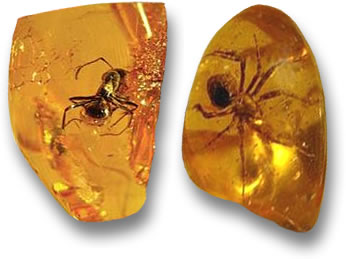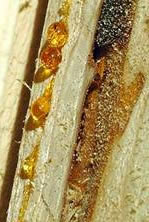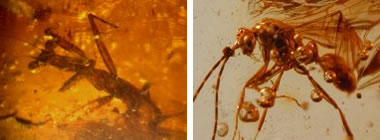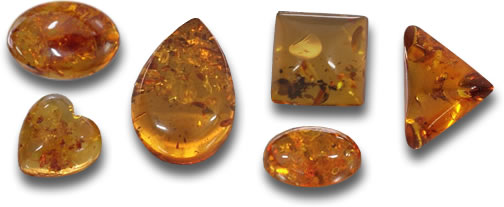GemSelect Newsletter - October 2011FOSSILIZED AMBER
 An Ant and a Spider Frozen in Time Inside Baltic Amber
Welcome to the amazing world of fossilized amber, otherwise known as fossilized tree resin. You may have seen fascinating pictures of small insects trapped inside amber. They have been there for millions of years! Lizards! If Pliny had actually seen lizards trapped in fossilized amber then he was certainly very lucky. Today, such gems are worth a small fortune. Most fossilized amber today is found in the Baltic regions; thus it's known as Baltic amber. Latvia, Poland and Russia are the usual areas in which it is found. However, since amber is light and can be swept around by the sea it is easily transportable. Therefore, amber has also been found washed ashore in Scandinavia, Germany and the UK.  Natural Wood Resin
Fossilized amber pieces have been found in the Dominican Republic that generally contain bigger insects (probably because it is in the tropics) and these are believed to be about 30 million years old! The clarity of the amber is also better, enabling the insects to be seen clearly. Ordinary amber is priced according to its size and clarity. However, the exception to the rule is when it happens to include an insect. In these cases the gem is worth a lot more, and it will depend on how clearly visible the insect is and how near the centre of the gemstone it is located. It's possible that some of the insects walked into the sticky mess or maybe, as many naturalists believe, the resin dropped from the tree onto the unfortunate insects below. Resin is a natural weapon of defense for the tree, designed to seal wounds and also to repel harmful insects, as well as attract friendly insects to kill insects and bacteria that may harm the tree. Therefore, it makes sense that resin and insects are found together. There are some very interesting examples of unlucky insects frozen in time millions of years ago, whilst going about their business. These include insects caught in spider's webs, ants transporting eggs and small mites hitching rides on the backs of beetles!  Unlucky Praying Mantis, (left)
Flying Ant (right) Andes Mountains, Columbia Fossilized amber was brought to the attention of the public during the film 'Jurassic Park'. Most amber found today was actually formed after dinosaurs had become extinct, during the Tertiary Period, which began about 65 million years ago. However, in the film, DNA is taken from dinosaur blood in the stomachs of mosquitoes (an interesting concept) and dinosaurs are cloned! Could this really be possible? Well, The British Museum of Natural History is investigating the idea. So, watch this space... Meanwhile there are stories of a piece of amber found in Gdansk, Poland, that holds a small lizard and, even more amazingly, there was a find in the Andes Mountains of Colombia of a small lizard entombed in amber - and there are pictures to prove it! The lizard, measuring 28 mm in length doesn't have a tail; a piece of the story that is lost to time. It is surrounded by insects. You can imagine the tropical forest floor and the buzz of the insects already caught in the amber in a mad struggle to free themselves, attracting the lizard, as he too walked into the trap.  Insects in Amber
They were all entombed together. A real scene from an ancient tropical forest millions of years ago! We have a varied selection of amber on our website, however, no amber gem containing a miniature fossilized dinosaur! However we do have lots of amber with inclusions showing bits of unknown vegetation and plant debris. So, if you want to try and clone a several million year old unknown plant species, now's your chance!  Baltic Amber from GemSelect
Customer Questions Back to Top
Every month we answer questions of general interest from our customers. Please feel free to send your questions or suggestions to our support team at help@gemselect.com! Question
I love your site. I was just wondering about Kasikorn Bank. I have never heard of them.
Answer
Kasikorn Bank is one of the major banks in Asia. In fact, you may have heard of one of their customers, which is Thai Airways, Thailand's national airline. They have been in operation since 8th June 1945 and have been listed on the Thailand Stock Exchange for over 30 years, since 1976. Their assets are currently valued at $54.4 billion.
Question
I received my gemstone certificate, but it does not mention the value of my gemstone. Why not?
Answer
The certificates are gemstone identification reports issued by independent gemological laboratories.
They identify and authenticate the gem type and details specific to the gem tested (such as weight, shape, dimension and treatment). They do not value the gemstone. In order to get the value estimated you need to contact an appraiser who is familiar with your country's gemstone market. We hope you found this article interesting. If you do have any comments or suggestions just drop us a line. We really do read every single email we receive and each email gets a personal response. Keep up with our new arrivals before they hit the newsletter by joining our thousands of fans and followers on our social networking pages. We love interacting with our customers - you can visit us on Tumblr, LinkedIn, Twitter, Facebook or Pinterest! To ensure you can receive our emails, please be sure to add help@gemselect.com to your list of safe contacts, or you add us into your email address book! Please feel free to contact us with any questions, comments and queries! We respond to each and every email we receive. Happy Gem Hunting! This Page in Other Languages
|
| STAY IN TOUCH | NEWSLETTER |
| *You're signing up to receive GemSelect promotional email. |
Copyright © 2005-2024 GemSelect.com all rights reserved.
Reproduction (text or graphics) without the express written consent of GemSelect.com (SETT Company Ltd.) is strictly prohibited.
1430